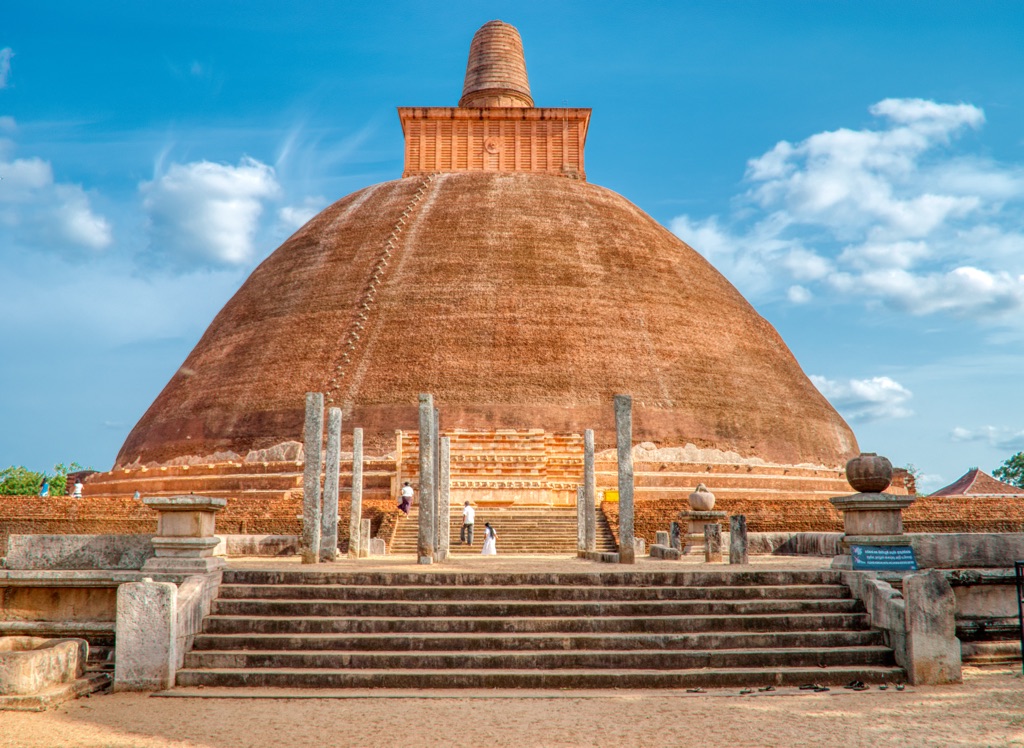The Jetavanaramaya is a significant historical and archaeological site located in Anuradhapura, Sri Lanka. It stands as a testament to the country’s ancient engineering prowess and religious devotion. This stupa, or Buddhist reliquary monument, was once among the tallest structures of the ancient world. It was built by King Mahasena of Anuradhapura (273–301 AD) and was completed by his son Maghavanna I. The monument signifies the acceptance of the Mahayana Buddhism sect in the region. Jetavanaramaya was not only a religious site but also a center of learning and housed thousands of Buddhist monks. Over the centuries, it has withstood invasions, natural disasters, and the passage of time, remaining an iconic symbol of Sri Lanka’s rich cultural heritage.
Get your dose of History via Email
Historical Background of Jetavanaramaya
The discovery of Jetavanaramaya dates back to the colonial period when British explorers and archaeologists took an interest in Sri Lanka’s ancient ruins. The stupa was built by King Mahasena, a ruler known for his extensive building projects. After his death, his son continued the work, completing the structure that would stand as a marvel of the ancient world. The Jetavanaramaya was a hub for the Theravada Buddhist tradition and played a pivotal role in the religious and social life of Anuradhapura.
Throughout history, the Jetavanaramaya has seen various phases of use and abandonment. It was a thriving center of religious activity during the Anuradhapura period. However, with the fall of the Anuradhapura Kingdom, the site faced neglect. It was not until the 20th century that restoration efforts began, bringing to light the grandeur of this ancient monument.
The stupa has been the scene of significant historical events. It was here that the Tooth Relic of the Buddha was hidden during times of war to protect it from invaders. The Jetavanaramaya also witnessed the shift in religious dynamics as Mahayana Buddhism gained prominence over the Theravada tradition in the region.
Later inhabitants included monks and pilgrims who visited the stupa over the centuries. The site continued to be a place of worship and pilgrimage, despite the political and religious changes in Sri Lanka. The Jetavanaramaya remained a symbol of the resilience and continuity of Buddhist tradition in the island nation.
Today, the Jetavanaramaya stands as a UNESCO World Heritage Site. It is a testament to the architectural and spiritual achievements of ancient Sri Lanka. The stupa continues to attract scholars, archaeologists, and tourists from around the world, eager to witness its historical significance firsthand.
About Jetavanaramaya
The Jetavanaramaya is a colossal stupa located in the sacred city of Anuradhapura. It was constructed using approximately 93.3 million baked bricks. The dome itself is an impressive structure made of these bricks, standing at a height of 400 feet (122 meters) at its peak. The compound covers an area of 8 acres, and the stupa’s base has a diameter of 360 feet (110 meters).
The architectural design of Jetavanaramaya is a reflection of the engineering skills of ancient Sri Lankans. The builders employed a unique compound known as “baked-brick and lime mortar” to bind the bricks together. This technique has allowed the structure to withstand the test of time and the elements.
One of the most striking features of Jetavanaramaya is its spire, which was adorned with precious gems and a pinnacle that once held a crystal. The stupa’s design follows the traditional “bubble shape” (anda), with a conical spire (kotha) rising above it. The harmonious proportions and the grand scale of the monument make it an architectural marvel.
The construction methods of Jetavanaramaya were advanced for their time. The builders had to account for the weight of the bricks and ensure the stability of the dome. They achieved this through precise calculations and the use of a sophisticated drainage system to protect the foundation from water damage.
The decorative elements of Jetavanaramaya include carvings and sculptures that depict various Buddhist motifs and stories. The stupa was once surrounded by a large monastic complex, which included a library, living quarters for monks, and educational facilities. These features highlight the cultural and religious importance of the site.
Theories and Interpretations
Several theories surround the purpose and significance of Jetavanaramaya. The primary function of the stupa was as a reliquary, housing sacred Buddhist relics. It is believed that the monument was constructed to assert the dominance of the Mahavihara monastic sect over the Abhayagiri sect, which followed the Mahayana tradition.
Mysteries also shroud the Jetavanaramaya, particularly regarding the relics it contains. Some believe that a part of the Buddha’s belt or sash is enshrined within the stupa, making it an object of veneration. The exact nature of the relics, however, remains a subject of speculation and reverence.
Interpretations of the site’s significance have evolved over time. Initially, it was seen as a symbol of the king’s power and piety. Later, it became a representation of the spread of Buddhism in Sri Lanka and the region’s religious history.
Dating of Jetavanaramaya has been carried out using historical records and archaeological evidence. The construction period is well-documented in the ancient chronicles of Sri Lanka, such as the Mahavamsa. Modern methods, such as radiocarbon dating, have also been used to confirm the age of the materials used in the stupa.
Theories about the construction techniques of Jetavanaramaya have led to a deeper understanding of ancient Sri Lankan engineering. The use of organic materials in the mortar, for example, has been studied to understand how the structure has survived for over a millennium.
At a glance
Country: Sri Lanka
Civilization: Anuradhapura Kingdom
Age: Constructed between 273–301 AD

